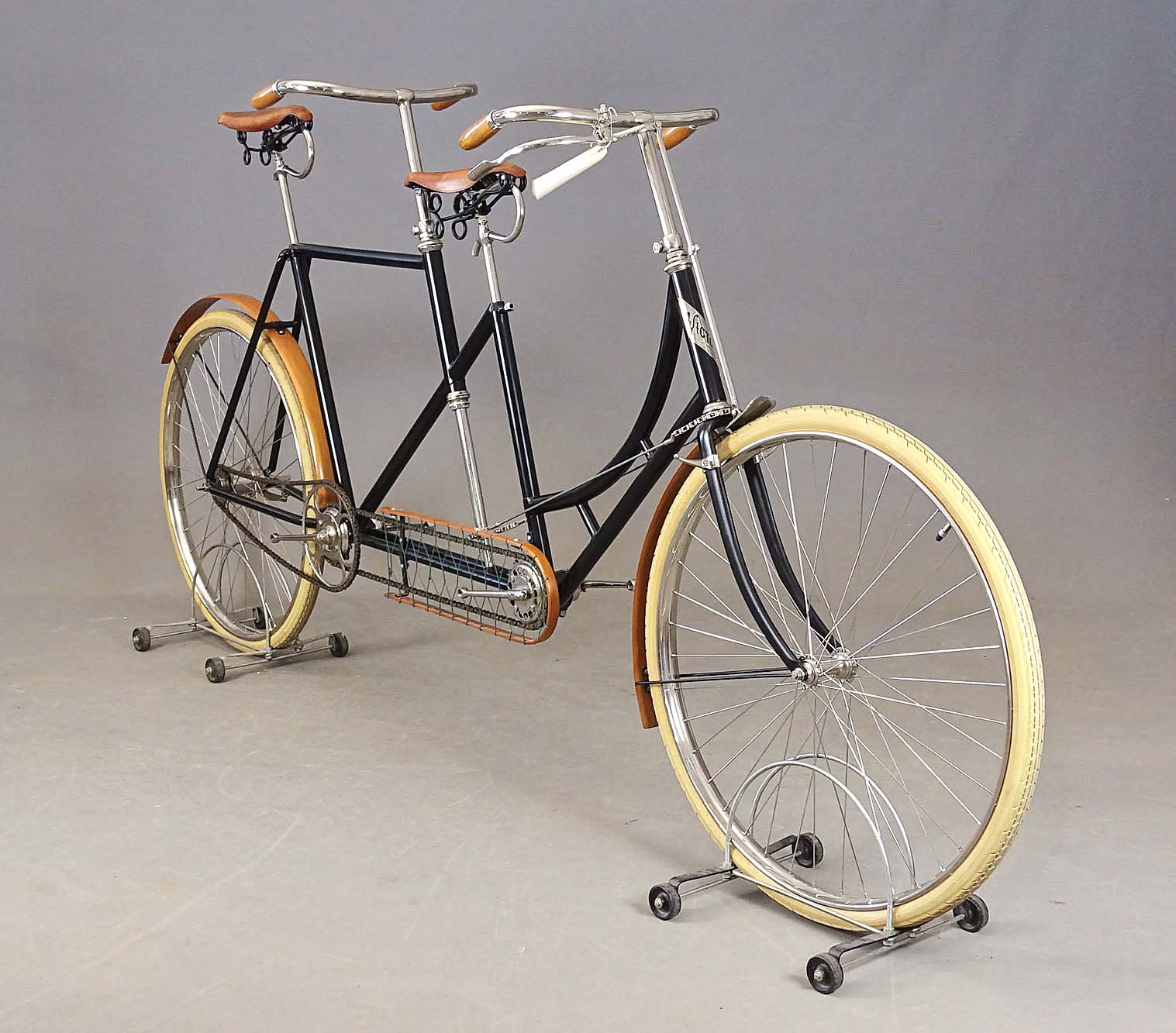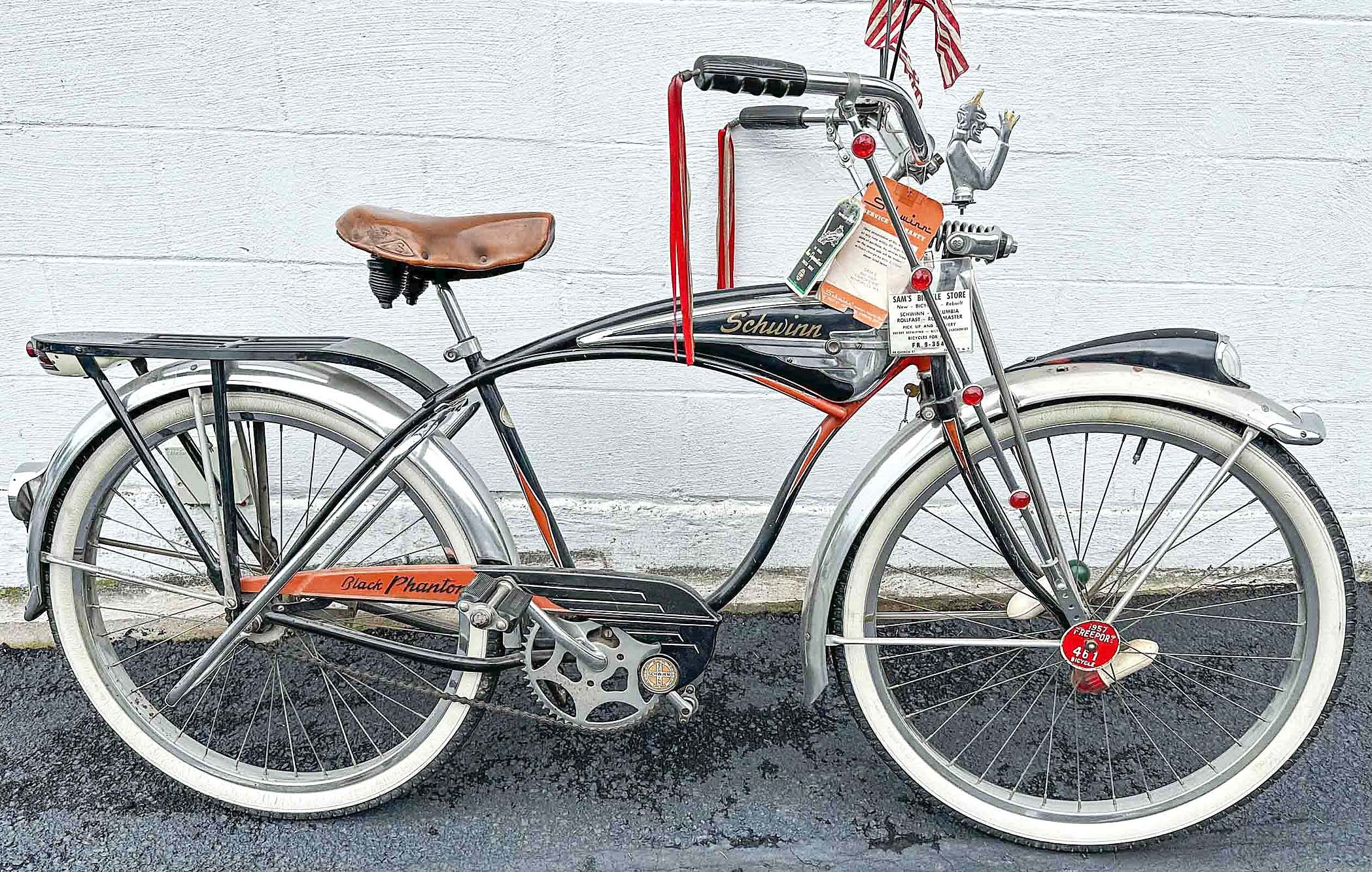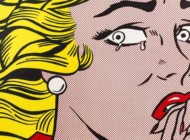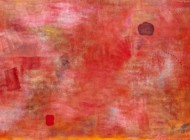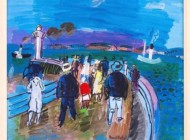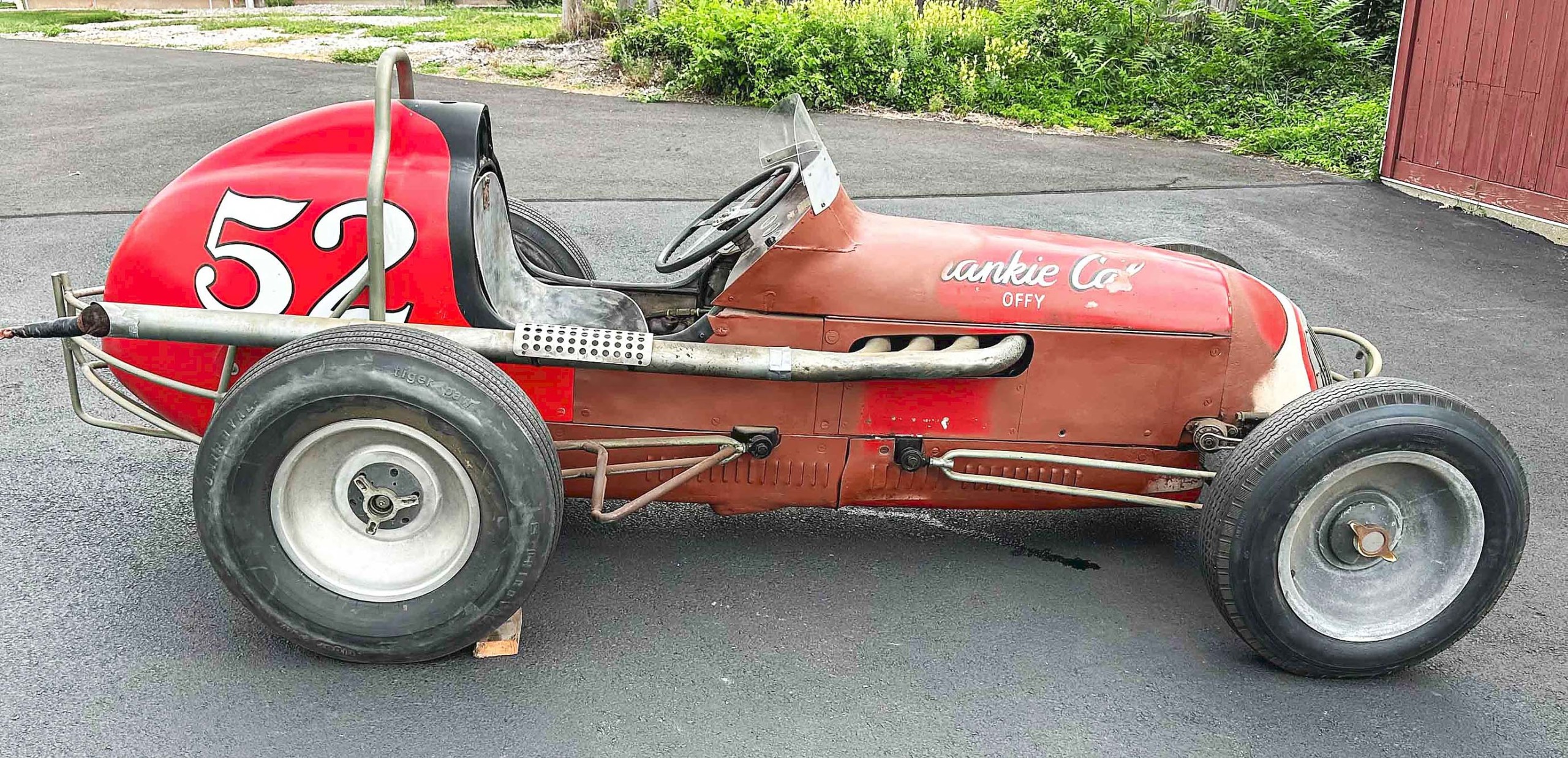
The checkered flag waved at $36,000 — the highest price of the auction — for this #52 Frankie Cal 220 Offenhauser sprint car, originally built in 1951 by Danny Hogan and rebuilt in the 80s by Ken Hickey, which was from the Himes Museum collection ($20/35,000).
Review by Carly Timpson
COPAKE, N.Y. — Copake Auctions celebrated its 33rd Annual Bicycle & Automobilia Auction on October 11, featuring the Steve Stevens collection from Colorado, the Meltz pedal car collection, the Marty Himes estate (The Himes Museum of Motor Racing Nostalgia, Bay Shore, N.Y.) and 120 antique and vintage bicycles from a European collector, among others. In total, the auction comprised more than 830 lots in all ride-on categories as well as accessories, advertising, art and ephemera related to the hobbies.
Seth Fallon, one of the firm’s owners, shared that the sale total of just about $600,000 was “probably in the top five” of all of Copake’s annual bicycle auctions. “This was just a really strong auction. We sold to about 10 countries, including Japan and just all over the world. For a smaller auction house, we do sell to pretty broad audiences. We have a really good following for these bicycle auctions. We had people in the audience from three different countries, as well as phone and internet bidders from all over. We also sold literature and items from both the bicycle and automobile sections to several institutions.”
Fallon told us that the Himes Museum collection came to Copake by way of another auctioneer, who specializes in automobile auctions but was not equipped to handle such a substantial sale on his own. So, Copake teamed up with him to catalog and sell the distinguished collection.

This 1947 Kurtis Kraft Offenhauser midget race car sold, for $16,800, with an original 30-by-23-inch sign board from the Himes Museum listing the car’s owners and drivers, as well as a selection of photographs, ephemera and racing outfits associated with the car ($12/20,000).
Racing to achieve the sale’s top price was a sprint car built in 1951 by Danny Hogan, having a custom chassis using components from a former midget car. Its engine, a 220 Offenhauser 11B, came from the Ernie Casale #14 Offy driven by Bill Zaring, Jimmy Daywalt, Cal Niday and Andy Linden in 1951. A year later, the car was sold to Frankie Calandrillo (Frankie Cal), giving the new build, using his engine, its name — the Frankie Cal #52 Offy. Rebuilt in the 80s by Ken Hickey, this car and historical records were in the collection of the Himes Museum and sold at Copake to a private Long Island, N.Y., collector, staying in the area where it was raced, for $36,000. Fallon noted that the firm did some extra advertising and outreach with this car, bringing it to Lime Rock (Lakeville, Conn.) and displaying it during one of the track’s concours days to generate additional attention.
It was another Offenhauser-powered race car from the Himes collection that crossed the block for a second-place finish, realizing $16,800. This example was a 1947 Kurtis Kraft midget. According to the catalog, “Kurtis Kraft was a high-quality midget chassis available in the 1940s-50s, and Kurtis midgets dominated the sport for two decades.” This example was originally owned by Frank Curtis of Newett, N.Y., and was campaigned successfully with many drivers, resulting in a substantial historical archive that was sold with the car. The file included photos, articles, programs and a signboard listing the car’s race history. It is also possible that this car was in the 1949 film The Big Wheel, starring Mickey Rooney, as photographs of him with this car are included in the archive.

Perhaps one of the most surprising results of the auction was the $5,700 realized for this collection of New York, New Jersey and New England race programs from the 1930s-40s ($200/400).
A selection of race programs from tracks around New York, New Jersey and New England from the 1930s and 40s left their $400 high estimate in the dust, crossing the finish line for $5,700. The catalog reported the collection was all graded in good to very good condition. Fallon noted that there were a few reasons a collection like this could take off as these did. “The race things did exceptionally well and that’s not really our wheelhouse, but the groups of photographs, literature and uniforms all did exceptionally well. There was a lot of interest in that stuff, it was from a really great collection and we grouped lots pretty well. It was a good opportunity for collectors to get large groups of memorabilia at once and sort through them. You can find single programs from races online all day long, but to get 50-60 of them at once is really rare. And they were owned by a racer so you have a little extra panache!”
The Himes Museum collection also contributed several lots of racing suits and jackets from various eras and leagues. Together, Fallon reported that the collection amassed about $17,000 and had diverse interest, including from vintage clothing dealers as well as the racing collectors he expected to see participating.
While race cars, racing suits, pennants and related racing ephemera made up the bulk of the Himes Museum collection, a few general motoring lots were included as well. One such lot was a large porcelain Flying A sign, advertising “Service.” This die-formed three-dimensional contour sign was single-sided and featured a 56-inch-long winged “A.” It flew beyond its $3,000 high estimate, reaching $7,500.

This large, 42-by-56-inch Flying A Service porcelain sign came from the Himes Museum collection and led the offerings of signs at $7,500 ($1/3,000).
The leading bicycle lot was a circa 1880s Star high-wheel bicycle by the H. B. Smith Company in Smithville, N.J. The bike, which was from the Stevens collection, had been restored and rides well; it bested its $4,000 high estimate, selling for $12,000. Fallon shared, “That brought a strong price and sold to a Wheelmen — a younger guy who was here with his wife. He only became a member of the Wheelmen and started coming to our auctions a few years ago, but he stuck it out and bought a pretty sophisticated bicycle.”
From the same collection, another circa 1880s high-wheel bicycle finished among the top five results. The white painted Rudge Kangaroo bicycle had a 37-inch front wheel and included its saddle and matching pedals. Despite some repairs, it was in fair condition and sold to a buyer from England, who was in the audience, for $9,600.
A circa 1890-92 Columbia Light Roadster high-wheel bicycle with a 52-inch wheel brought $6,000, doubling its $3,000 high estimate. This example had cowhorn handlebars with spade grips and a fourth pattern Kirkpatrick saddle. As an added bonus, this bicycle sold with its stand.
On the smaller end of high-wheel bicycles was a 36-inch Crypto Bantam from the Stevens collection. In “barn-fresh” condition, the Crypto Bantam had two styles of special grips for racing. It sold for $5,700.

Sold together after being restored as a set, these circa 1915 Iver Johnson father-and-son bicycles with rifles brought $9,000 ($2,5/3,500).
Two Iver Johnson bicycles were sold together as a father-son set. The pair was restored together by Dick Rath of Time Machines, Ltd., to match as closely as possible, each had red tires, white pedal blocks, matching luggage racks with oak crossmembers, saddles and tool pouches. Additionally, each bicycle was mounted with a rifle — the larger with a circa 1915 Iver Arms .22-caliber rifle and the smaller with a circa 1915 Daisy BB gun. This sporting duo achieved $9,000, selling to a Canadian collector in the room, who was an Olympic bicyclist.
Also made for a pair was a Victor Victoria pneumatic safety tandem, female/male combo. This circa 1897 bicycle was restored by Robin Willan of Christchurch, New Zealand, as documented in a letter from its previous owner, Dave Walker. The bike was sold — with matching pedals, its original catalog, block chains and other ephemera — for $4,200.
Purchased new by Marty Himes in 1952, a now vintage Schwinn Black Phantom bicycle in original condition brought $5,400. Fallon reported that this bicycle “was like a time capsule.” Probably never ridden, at least not extensively, the balloon-tire bicycle had its original tags affixed to its handlebars and sold to a buyer in Hawaii who has bought from Copake before.
Though not in all-original condition like the Schwinn, an Indian bicycle with sidecar had “a really fabulous restoration,” according to Fallon, and sold to an online collector for $4,800. Made by the Indian Motorcycle Company in Springfield, Mass., this bike and sidecar were found in an Indian Motorcycle dealership in New York in the late 1930s. The sidecar was painted to advertise “Sales & Service” on the side, while the rear read “Indian Motorcycle Sales / Phone 7737.” The restoration was done by Kid Dean and it appeared in Evolution of the Bicycle, Volume 2 (1994) and “won at Ann Arbor for Best Restored Bike,” according to the catalog. “It was just a very cool thing and was very rare to see with the sidecar, too.”
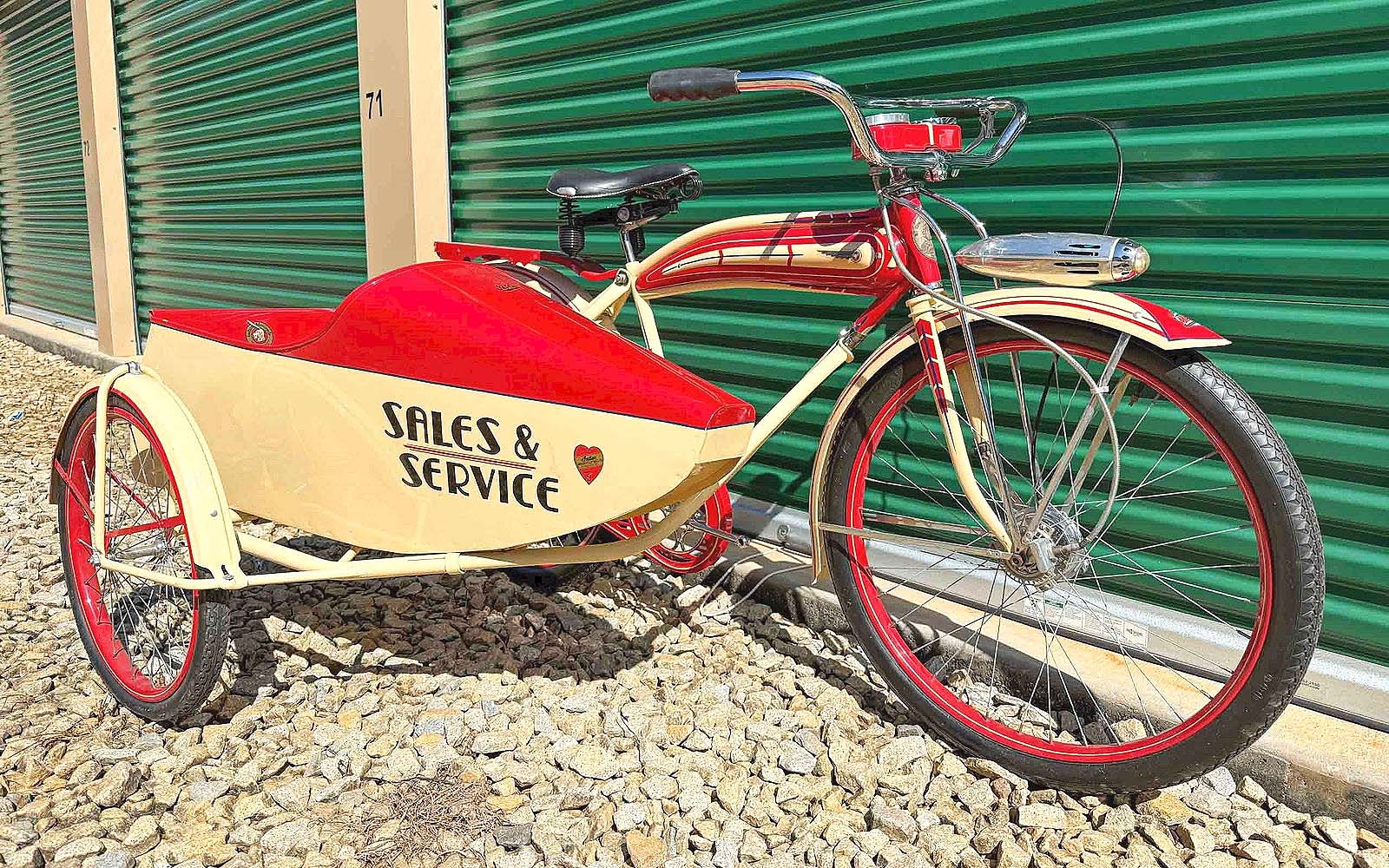
Bearing an “Indian Motorcycle Co. / Springfield, Mass. USA” emblem on its front and reading “Sales & Service” on the outside panel of its sidecar, this bicycle had been restored by Kid Dean and earned $4,800 ($2,5/3,500).
Another notable result was that of a rare circa 1880-89 high wheel bicycle trophy. “It was just a sophisticated high wheel trophy, probably one out of 100 design. Any time you have a trophy with actual physical bicycles on them, especially high wheel period, they tend to do well,” remarked Fallon. This trophy, made by Meriden Brittani [sic] & Company, Meriden, Conn., featured two riders with their bicycles and was engraved with floral details. It brought $3,000.
Additionally, Fallon reported, “We had over 200 bicycle lamps in this sale. That’s a lot of lamps to sell in one sale but they were really well received. The top one sold for $1,680, which is a great price.” This top lot was an early 8-inch Columbia hub high wheel lamp. In good condition, the lamp’s engraved plate reading “Columbia Lamp / Made By / The Pope Mfg. Co. / Boston” was still legible with no scuffs or tarnishing.
Prices quoted include the buyer’s premium as reported by the auction house. For information, www.copakeauction.com or 518-641-1935.




